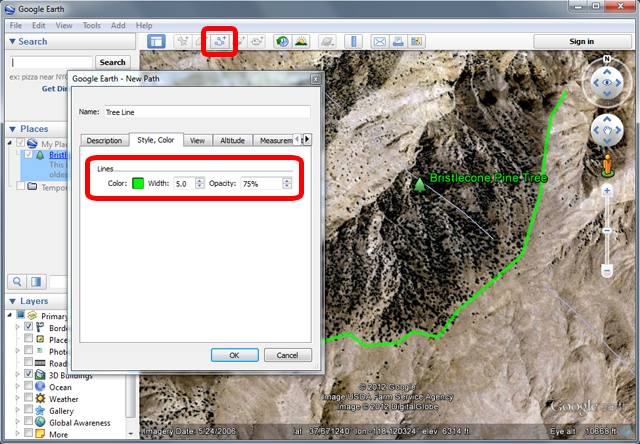

- Turn on Weather view from the Layers button in the bottom left corner. Click the drop-down negative sign and next to Weather and click both the 'Radar' and 'Clouds' options. You'll be able to see rain and snow and clouds and sleet on this map, just like you were looking at a weather radar on a TV screen weather broadcasting channel.
- Turn on other buttons for additional items to view about the location. You can turn on YouTube videos when these videos have been placemarked. Look through that list, and see if you can turn on other very useful features that show the world from the eyes of other viewers.
- Viewers who love Hybrid mode on Google maps or the Hybrid mode on their iPhones or Android devices, may like to turn on the 'Roads' aspect which shows you the roadways.
- Utilize subway systems and lines that show where subways lines are by turning on Subway from the Transportation drop down of the 'More' drop-down button (click More, then Transportation, then select Subway).
- Get traffic data for specific big metropolitan cities (US and Canada) by turning on the Traffic from the 'More' drop-down.
- Give yourself some Wikipedia data. Turn on the Wikipedia option and you'll see data about the towns you're reading up on.
- Look at the locations of epicenters to recorded earthquakes by turning on the Earthquake feature in the Gallery drop-down.
- View pictures of the Ocean floor after turning on some of the Ocean options. There are several pieces marine biologists may enjoy after they zoom into some oceans enough. You might want to turn on both the 'Explore the Oceans' and 'Shipwrecks' options to see incredible imagery of items below the ocean surface. Also included are 'Dead Zone' data where fish tend to die off when they enter these areas.
- Look at other things on the Earth to learn more about what you don't see or know very well. With some of the other contributors including 'National Geographic', NASA, and 'Discovery Networks' after turning on these features, or even one of the many other features, you're never far away from many ideas to learn more about your world. There are lots of things you can turn on to learn a little more about your world.
How To Use Measure Tool On Google Earth For Mac
- To measure a distance between two or more points in Google Maps, touch and hold anywhere on the map to make a red pin appear, and tap the name of the place at the bottom of the screen.
- Classic desktop Earth must be downloaded and installed on your Windows, Mac or Linux computer. By making new Earth a web app (on Chrome, for now) it can be used on most computers including.
- In actuality, even Google Earth is a compromise so would love to hear of any nice Apps that allow me to use an existing map or nautical/aeronautical (or even a roadmap or Geopolitical map) to determine distances - and maybe even some other nice features as well.
How To Use Measuring Tool On Adobe
Google updated the Google Maps app for iOS on Wednesday and brought a useful measurement feature to iPhone and iPad that has been available on the Maps web interface for some time.